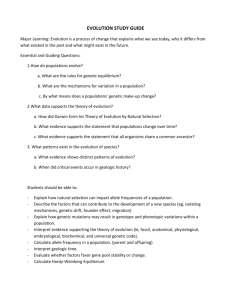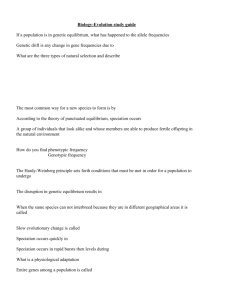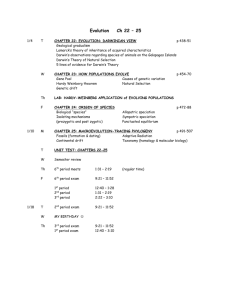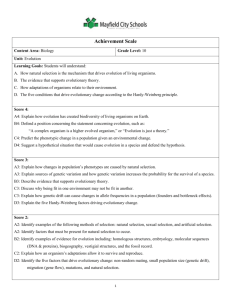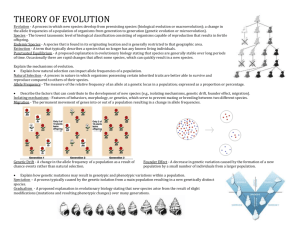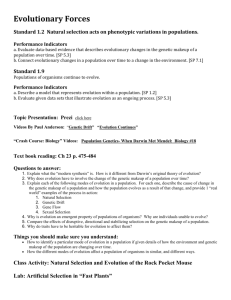James hutton Gradualism Profound geological changes take place
advertisement
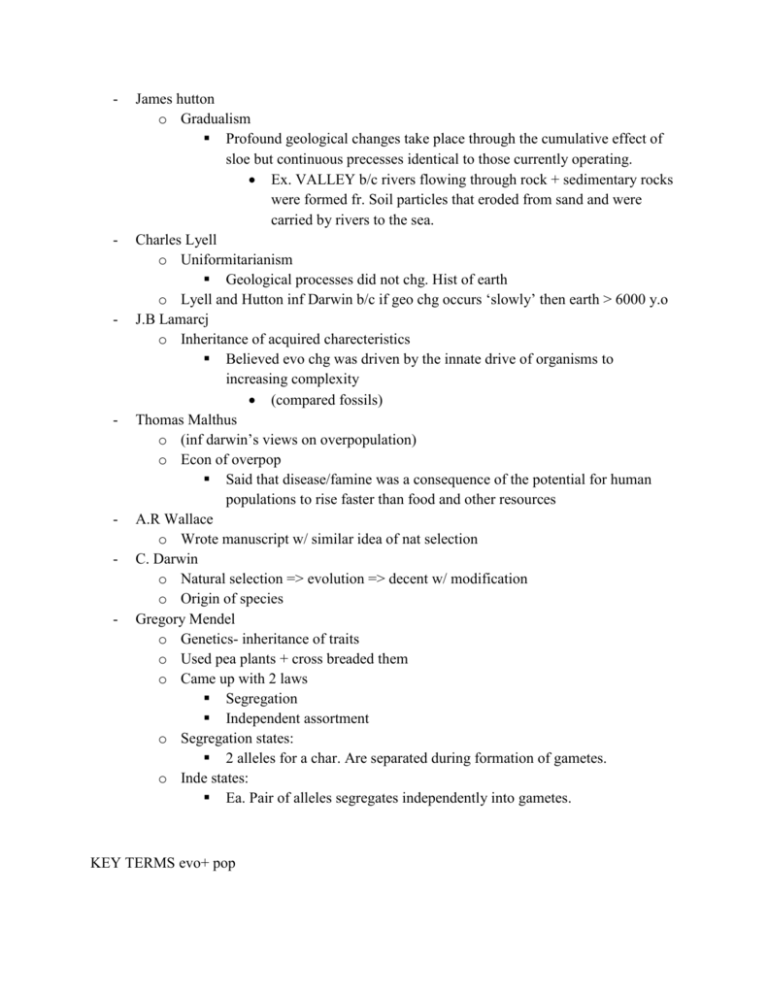
- - - - - - James hutton o Gradualism Profound geological changes take place through the cumulative effect of sloe but continuous precesses identical to those currently operating. Ex. VALLEY b/c rivers flowing through rock + sedimentary rocks were formed fr. Soil particles that eroded from sand and were carried by rivers to the sea. Charles Lyell o Uniformitarianism Geological processes did not chg. Hist of earth o Lyell and Hutton inf Darwin b/c if geo chg occurs ‘slowly’ then earth > 6000 y.o J.B Lamarcj o Inheritance of acquired charecteristics Believed evo chg was driven by the innate drive of organisms to increasing complexity (compared fossils) Thomas Malthus o (inf darwin’s views on overpopulation) o Econ of overpop Said that disease/famine was a consequence of the potential for human populations to rise faster than food and other resources A.R Wallace o Wrote manuscript w/ similar idea of nat selection C. Darwin o Natural selection => evolution => decent w/ modification o Origin of species Gregory Mendel o Genetics- inheritance of traits o Used pea plants + cross breaded them o Came up with 2 laws Segregation Independent assortment o Segregation states: 2 alleles for a char. Are separated during formation of gametes. o Inde states: Ea. Pair of alleles segregates independently into gametes. KEY TERMS evo+ pop - - - - - - Specie o Ernt Mayr said “ (biological species concept)” A pop which can be based and create fertile offspring- but cannot produce fertile offspring w/ another specie Specie is based off infertility NOT physical appearance Gene pool o Prezygotic + postzygotic barriers isolate the gene pools of biological species Read detail in book + lots of info on this LOOK AT CLIFFS 134+ 137 Evidence for evo o See my original S.G… this is too complex to write in a word doc Radioactive Decay o ???????????????!!!!!!!!!!!!!!!! Comp. Anatomy o Homologous structures Sim. Due to shared ancestor As time progresses – things become useless b/c our ancestors needed them but we don’t (appendix) o Analogous structure From convergent evo. When 2 organisms fr. Diff. evo lineages exp. Sim enviro pressures => nat selection will give some same traits Embryology o ?????????????????!!!!!!!!!!!!!!!!!! Biochemistry o sometimes called biological chemistry, is the study of chemical processes in living organisms, including, but not limited to, living matter. Modern synthesis o The modern evolutionary synthesis is a union of ideas from several biological specialties which provides a widely accepted account of evolution H-W principle. I am not taking the time to write this… look at my written guide plz. • Genetic drift – when a sudden change in a population occurs when population <100 can take great effect on population • Bottleneck effect – when a population takes a population decrease. Like in a natural disaster, this can cause a huge change in genetics of population • Founder effect – population started by few individuals so very little genetic variation. Only works with random mating and no gene flow • Speciation o Subspecies – Subspecies in biological classification, is either a taxonomic rank subordinate to species, or a taxonomic unit in that rank. A subspecies cannot be recognized in isolation: a species will either be recognized as having no subspecies at all or two or more, never just one. o Anagenesis – gradual transformation of one species into another o Microevolution –the changes in allele frequencies that occur over time within a population o Macroevolution – Cliffs pg 138. Changes in allele frequencies over time over species as a whole o Allopatric speciation – Cliffs pg 135. Geographic separation Adaptive Radiation – Cliffs pg 136. Evolution of diversely adapted species form common ancestor when new environmental condition arise. (mammals after dinosaurs went extinct) o Sympatric speciation – Cliffs pg 135. Based on biological factors. Non-random mating, chromosomal changes Autopolyploid – common in plants, self fertilizes and creates new species Allopolyploid – new species from at least two different species o Polyploidy – multiple sets of chromosomes o Puncuated equilibrium vs. gradualism – Punctuated equilibrium is a “sudden change” looks like new species suddenly after stasis. Gradualism is a constant but slow geological change that takes place over time. • Mechanisms-Reproductive barriers – Cliffs pg 137 Genetics: p. 89 in CLIFFS - - - - F1 gen (1st filial gen) F2 gen (2nd filial gen) P gen ( Parental gen) Mendel Laws o See pg. 1 Laws of Probability o WTF? Gene o Locus Genetic info coded in a locus is a gene Position of gene on a chromosome Allele o 1 of 2 or more act. Forms of a gene that arise by mutation & are found in the same place as a chromosome Incomplete dominance o Heterozygots show a distinct intermediate phenotype not seen in homozygotes. NOT BLENDING INHERITANCE b/c traits are seperable as shown in further crosses o (snap dragons) Codominance o (cliffs 94) Homozygous vs heterozygous - - ???????????!!!!!!!!!!!!!1 Genotype vs phenotype Phenotype= Actual expression of gene Genotype= Represents actual allele Genetic crosses o Punnent square – see pg 92 cliffs Used to see all possible ways in which gametes can combine o Monohybrid cross PP*pp o Dihyb cross YYRR*yyrr o Test cross P.93 cliffs o Pedigree Anything purebred Non mend inheritance o Epistasis P. 95 cliffs for everything ESSAY QUESTIONS AND AnsWERs 1. Define, discuss, and give an example of how each of the following isolating mechanisms contributes to speciation in organisms. a. Geographical barriers b. Ecological (including seasonal) isolation c. Behavioral isolation d. Polyploidy 2. Describe the modern theory of evolution and discuss how it is supported by evidence from two of the following three areas: a. Population genetics b. Molecular biology c. Comparative anatomy and embryology 3. Phylogeny is the evolutionary history of a species. a. The evolution of a species is dependent on changes in the genome of the species. Identify two mechanisms of genetic change, and explain how each affects genetic variation. b. Based on the data in the table below, draw a phylogenetic tree that reflects the evolutionary relationships of the organisms based on the differences in their cytochrome c amino-acid sequences and explain the relationships of the organisms. Based on the data, identify which organism is most closely related to the chicken and explain your choice. c. Describe two types of evidence, other than the comparison of proteins, that can be used to determine the phylogeny of organisms. Discuss one strength of each type of evidence you described. The number of amino acid differences in cytochrome c among various organisms Horse Donkey Chicken Penguin Horse Donkey Chicken Penguin Snake 0 1 11 13 21 0 10 12 20 0 3 18 0 17 Snake 0 4. Do the following with reference to the Hardy-Weinberg model. a. Indicate the conditions under which allele frequencies (p and Q) remain constant from one generation to the next. b. Calculate, showing all work, the frequencies of the alleles and frequencies of the genotypes in a population of 100,000 rabbits of which 25,000 are white and 75,000 are agouti. (In rabbits the white color is due to a recessive allele, w, and agouti is due to a dominant allele, W.) c. If the homozygous dominant condition were to become lethal, what would happen to the allelic and genotypic frequencies in the rabbit population after two generations? 5. Evolution is one of the unifying concepts of modern biology. A. Explain the mechanisms that lead to evolutionary change. B. Describe how scientists use each of the following as evidence for evolution: 1) Bacterial resistance to antibiotics 2) Comparative biochemistry 3) The fossil record 6. Darwin is considered the “father of evolutionary biology.” Four of his contributions to the field of evolutionary biology are listed below. -The nonconstancy of species -Branching evolution, which implies the common descent of all species -Occurrence of gradual changes in species -Natural selection as the mechanism for evolution A) For EACH of the four contributions listed above, discuss one example of supporting evidence. B) Darwin’s ideas have been enhanced and modified as new knowledge and technologies have become available. Discuss how TWO of the following have modified biologists’ interpretation of Darwin’s original contributions. -Hardy-Weinberg equilibrium -Punctuated equilibrium -Genetic engineering 1. a. Geographical barriers. Geographical barriers are natural barriers that prevent animals from mating with one another. Certain animals cannot pass certain geological structures (like across an ocean) and therefore would be unable to mate with each other. A bird on one gallapagos island cannot likely mate with a bird from a nother island. b. ecological (incuding seasonal) isolation. The isolation of competing species of organisms made possible by differences in each species food resources, habitat use, activity period, or geographical range. seasonal isolation is where certain animals cannot breed with one another due to them breeding at different times of the year. Ex. different breeds of cicadas breed at summer and others in the winter. c.behavioral isolation. behavioral isolation makes animals not breed due to breeding behaviour. ex. certain birds impress with songs and the tune may not be the right one form one bird species to antoher d.polyploidy: multiple sets of chromosomes. like in plants, too many chromosomes so cannot reproduce with others without same number of chromosome pairs. aka sterile. another example is a mule a little helpful site. http://www.anselm.edu/homepage/chieber/itopic14.html 2. ??!! 3. Phylogeny is the evolutionary history of a species. a. The evolution of a species is dependent on changes in the genome of the species. Identify two mechanisms of genetic change, and explain how each affects genetic variation. Possible answer: There are eight main methods of genetic change: genetic flow, genetic drift, mutations, diplodity, outbreeding, balanced polymorphism, vertical transfer of genetic material (sexual reproduction), and horizontal transfer of genetic material (transposons). 4. a. Allele frequencies remain constant when there is a large population, no migration, no mutations, random mating, and no natural selection. b. p + q = 1 p2 + q2 = 1 q2 = 0.25 q = 0.5 p + q = 1 therefore p + 0.5 =1 and p = 0.5 p2 + 2pq = 0.75 c. the homozygous dominant section of the population, 25%, would die out completely within two generations, meaning that the remaining genotypes would only be Aa and aa. When you put these in a punnett square, you get a 50/50 ratio for Aa/aa genotypes. trujillo if you see a way to refute this logic please inform me my understanding is that it would make a regualr punnet square with the homozygous dominantdying out. meaning there would be a 1:2 ratio of homozygous rec to heterozygous. this would mean that that the new p squared would be .33. which means p =.57 and q = .43 5. a. mechanisms leading to evolutionary change: natural selection, survival of the fittest, anagenesis, cladogenesis, speciation? you guys what am I missing here b. 1) bacterial resistance to antibiotics can be used as evidence for evolution because the antibiotics kill only certain strains of the bacteria and then the survivors procreate, generating a bacteria population that is almost entirely resistant to the antibiotic. 2) comparative biochemistry can be used in this way because there are innate similarities in nearly all organisms, for example DNA and RNA code for the storing and release of energy in the same way, indicating a common ancestor. 3) the fossil record is evidence of evolution because it allows us to track the descent of current or more recent species from older ones. Through the various strata of the fossil record we may track ways in which various species have evolved and can incorporate radiometric dating and molecular clocks to figure out on what timescale these have occurred. 6. a. 1) The nonconstancy of species. Im not too sure about this one, but i think this might be sorta almost right. species can be traced to have evolved from ancestors, with changing traits such as gaining or losing apendiges to help them survive and continue to reproduce. 2) Branching evolution, which implies the common descent of all species. This can be seen by looking at the bones in the wing of a bat, the hand of a human and the flipper of a whale, all have the same bones, but they have changed to adapt to the situation they are used for. 3) Occurence of gradual changes in species. This can be seen by looking at horses and seeing how their single hoof and large size can be traced back through gradual changes from multiple appendinges to only one large middle one and from being small to gradually growing smaller. 4) Natural selection as the mechanism for evolution. This can be seen by peacocks, the flashier, prettier peacocks, have a higher chance to mate because they are healthy which increases their fitness b - H-W equilibrium o Darwin posed theory of evolution and of ‘descent w/ modification’ H-W says that eventually a species will reach a peak and stop evolving equilibrium • all traits are selectively natural • no mutations • pop must be iso from other pop • pop= large so no gen drift • mating=random - Punctuated Equilibrium o Darwin posed theory of evolution and of ‘descent w/ modification’ Punctuated equilibrium argues that evo history consists of geologically long periods of equilibrium w/ little evo evo occurs in short periods of rapid chg. Genetic engineering. Genetic engineering allows scientists to manually change the genes in species in order to give it beneficial traits it may not otherwise resive. Ex. a freeze resistent trait being taken from a fish and put into a strawberry so that it will not freeze 1. Genetic flow is the introduction of new genetic material from a new population. This can produce new variations of a phenotype. For example, the B blood type might have originated from Asia, so if we have a population of people elsewhere with only A blood type, interbreeding will lead to greater genetic variation 2. Genetic drift is a shift of allelic frequencies by random sampling (ex. probability of rolling die will not always be 1/6 for getting 6 out of the roll) Note: Genetic flow and Genetic drift are more related to changes in allele frequencies, but is related to genetic variation 3. Mutations also changes the genome (the set of all genes in an organism) •Point mutation = a change on 1 base (there is a sequence of A, G, T, C in DNA, and each are called ases)- ex. sickle cell anemia •Frameshift = the addition/removal of 1 base; DNA is read in sequences of three: ex. there can be a sequence of CAATATGAC, and when the DNA is being read like an instruction manual (during RNA transcription), it will be read as: CAA TAT GAC, but the addition or removal say add a T at the beginning will cause the sequence to be read as TCA ATA TGA C (which will cause a big change) •Transposable elements (discussed later) 4. Diploidity= because each organism have two sets of chromosomes, in examples such as heterozygote advantage, where you have the recessive allele hidden from natural selection, it allows the information to be kept until new selective pressures cause a, for example, directional shift (so diplodity helps maintain genetic variation) 5. Outbreeding is basically little sexual selection, which helps keep genetic variation and keep probabilities “fair” (as in a die)outbreeding helps maintain strong genetic diversity through breeding of individuals that aren’t closely related 6. Balanced Polymorphism = there are many types of phenotypes (this is like the genetic flow example), and with many types of phenotypes, they can be maintained through •Heterozygote advantage •Frequency-dependent selection = those with a rarer phenotype will tend to survive better because predators do not recognize them as readily 7. Sexual Reproduction = recombination and shuffling of alleles is a big part of Natural Selection 8. Horizontal Transfer= transposable elements; viruses are very adept at adding “snipets” of genetic codes into other organism’s DNA


